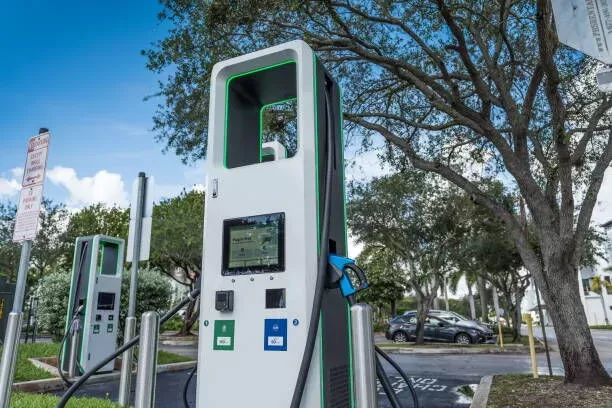Notifications

7 minutes, 40 seconds
-152 Views 0 Comments 0 Likes 0 Reviews

Introduction
The rapid adoption of electric vehicles (EVs) is transforming the transportation industry, creating a strong demand for efficient charging infrastructure to support this shift. Among the various types of EV chargers, DC EV chargers, also known as Level 3 chargers, are essential for enabling quick recharges, significantly reducing charging times from hours to just minutes. These chargers play a crucial role in facilitating long-distance travel and enhancing convenience for on-the-go EV drivers. In this article, we explore the role of DC fast chargers, the factors influencing their placement, and how strategic deployment can support widespread EV adoption.
What is a DC Fast Charger?
DC fast chargers are high-powered stations that convert alternating current (AC) from the grid into direct current (DC), which is then delivered directly to an EV’s battery. By bypassing the vehicle’s onboard converter, these chargers provide much higher voltage, enabling rapid charging. Unlike Level 1 and Level 2 chargers, which are more suited for home or workplace use, DC fast chargers are critical for public spaces and high-traffic locations where quick recharging is needed. These chargers can recharge up to 80% of an EV battery in as little as 20-30 minutes, effectively addressing "range anxiety" and improving the overall EV ownership experience.
Types of EV Chargers
Level 1 Chargers: The slowest option, using a standard 120V outlet, providing about 2-5 miles of range per hour of charging. These are typically used for overnight home charging.
Level 2 Chargers: Faster than Level 1, using a 240V outlet, they provide about 10-60 miles of range per hour of charging, making them suitable for residential, commercial, and workplace use.
DC Fast Chargers: The fastest charging option, using 400V-800V or higher voltages, designed for public spaces and high-demand areas, offering rapid charging to ensure EV drivers can get back on the road quickly.
The Importance of Strategic Placement for DC Fast Chargers
The placement of DC fast chargers is key to their effectiveness. While their fast charging capabilities make them highly attractive, their utility is greatly influenced by how accessible and convenient they are to users. Poor placement can lead to underutilization, while strategic placement maximizes their impact on the EV ecosystem.
High-Traffic Areas: Placing DC fast chargers along highways, interstates, and busy roads ensures they serve long-distance travelers who need quick recharges. Rest areas, gas stations, and roadside diners are ideal locations for these chargers.
Commercial and Retail Centers: Shopping malls, grocery stores, and restaurants are excellent venues for DC fast chargers. They provide an opportunity for drivers to charge while they shop or dine, and businesses benefit from increased foot traffic.
Residential and Multi-Unit Housing: As EV adoption grows in urban areas, the need for accessible public charging stations becomes more important. For residents of apartments or condominiums without private charging, nearby DC fast chargers are a valuable resource.
Public Transport Hubs: Locations like train stations, bus terminals, and airports are prime spots for DC fast chargers due to the constant flow of vehicles and passengers. These locations ensure that both individual EV drivers and transport fleets have access to fast charging.
Workplace Charging: Offering EV chargers at workplaces can be an attractive employee benefit, aligning with sustainability goals. However, challenges such as restricted access and oversubscription among employees need to be addressed.
Choosing the right location for DC fast chargers involves several important technical, regulatory, and logistical considerations:
Access and Convenience: Chargers must be easy to find and access, with ample parking, clear signage, and proper lighting to ensure user safety. Compliance with accessibility standards (e.g., ADA requirements) is also essential for inclusivity.
Power Supply: DC fast chargers demand a strong electrical infrastructure. Locations with existing high-voltage supply are preferable, as they can accommodate multiple chargers without major upgrades. Utility companies may need to collaborate to enhance power infrastructure where necessary.
Grid Capacity: The site must have the grid capacity to support the additional load from fast chargers. Grid impact assessments, along with solutions like renewable energy sources or battery storage, may be needed in some areas.
Safety Regulations: Compliance with local safety regulations and industry standards is critical for ensuring safe installations. This includes proper fire safety measures and electrical certifications.
Electrical Connections: The installation of DC fast chargers requires careful consideration of cable management, load balancing, and voltage requirements. Collaborating with experienced contractors ensures efficient and safe installations.
Increased EV Adoption: Accessible and convenient fast chargers reduce range anxiety and encourage more people to adopt EVs.
Revenue Generation: Strategic placement in high-traffic areas and commercial centers can generate revenue through charging fees and increased foot traffic.
Environmental Benefits: By supporting EV adoption, DC fast chargers contribute to reducing greenhouse gas emissions, helping cities and regions meet sustainability targets.
Improved User Experience: Well-placed chargers minimize wait times and improve the convenience of EV ownership, making it a more attractive option for drivers.
The success of DC fast chargers hinges not only on their advanced technology but also on their strategic deployment. High-traffic locations like highways, commercial centers, and public transport hubs are prime areas for fast chargers, offering convenience and accessibility to EV drivers. By addressing key factors such as power supply, grid capacity, and regulatory compliance, stakeholders can ensure that these charging stations meet the needs of both users and developers. As the EV market continues to grow, well-planned charging infrastructure will be a crucial part of accelerating the shift toward sustainable, green transportation.Know more about Google SEO Directory
China EV Chargers EV Charger Manufacturer EV Charging Solutions

